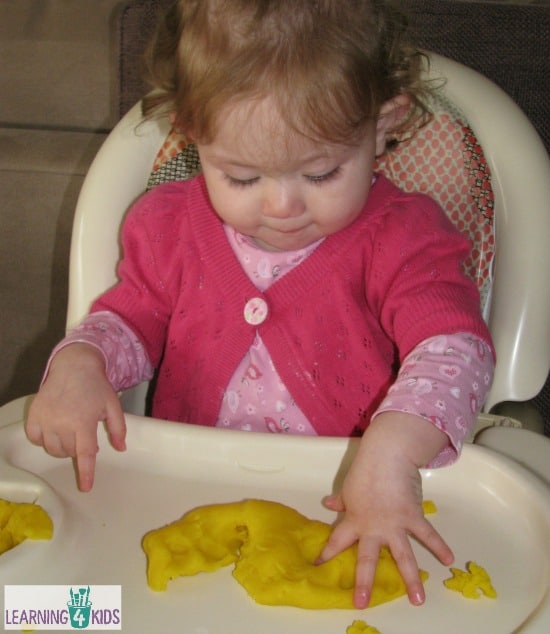
I have always loved watching little chubby fingers squishing and squashing play dough. I am not really sure what it is that I adore so much but I think it has something to do with the educator in me….that is, I know how GOOD play dough is for young children.
Educationally, play dough ticks all the boxes for learning and development. The sensory nature of play dough allows babies and toddlers to be naturally curious and explore the world around them using their senses. It is also beneficial for fine motor development and strengthening little fingers, hands and wrists. As children grow and develop, play dough also grows with them and is so versatile for different learning experiences such as imaginative play. Plus kids absolutely love it!
A regular question I receive from readers is ‘when is it okay to introduce play dough to my baby or toddler?’ To give an answer to this question really depends on your child and level of ability. Also every child is different (as it should be) with different interests. I think the most important thing to remember, when you do chose to introduce play dough to your child for the first time, is that you supervise, encourage and model positive play dough behaviours.
What you will need?

I have always made my own play dough because it is so simple and cheap to make at home. There are so many play dough recipes out there, some better than others, some that you cook, others do not require cooking. I find it more cost effective to make my own and I know what ingredients I have put into the play dough, particularly when kids are likely to eat it.
A great ‘first time’ play dough recipe to try is our Edible Play Dough Recipe for Babies
My favourite play dough recipe that I always love to make is our Homemade Basic Play Dough. This play dough is not too dry and doesn’t leave a greasy residue on your hands. It has a lovely smooth consistency and lasts longer than no salt play dough recipes. This play dough is shown in the in the pictures below.
Let’s Play

Some Tips and Ideas:
- Play dough is a great way to introduce some new vocabulary words such as squish, squeeze, sticky, etc.
- Encourage babies and toddlers to manipulate the play dough using repetitive words such as poke it, squeeze it, pull it, pat it and squish it.
- Discourage children not to put the play dough into their mouths, it’s not wrong or naughty, they are trying to explore the world around them the best way they know how, through their senses. If they do put it into their mouths, discourage it by saying things like, ‘yucky’ or what other words your child understands means not to do it.
- Model appropriate play dough behaviours. Play with the play dough too and model squeezing it, poking it and so on! Laugh and smile, showing your child that it is a fun and an enjoyable experience. Make things with the play dough such as a smiley face and talk about it while showing your child.
- Sing songs: Take old favourite songs or nursery rhymes and change the words to match the play dough experience. For example the song “This is the way….so early in the morning” is easy to adapt for play dough fun. “This is the way we squeeze the play dough, squeeze the play dough, squeeze the play dough. This is the way we squeeze the play dough, so early in the morning.”
- Always Supervise!!
Lets Learn

Play dough is not only a great tool for promoting fine motor coordination and strength but also developing oral language. Manipulating play dough builds and develops strength and control in the hands, fingers and wrists. This strength and control supports the use of writing tools, scissors and the ability to throw and catch objects. Playing with play dough encourages oral language development through talking about the experience and what is happening. It provides an opportunity to use repetitive language and sing songs.

Love this article on introducing play dough to babies and toddlers – I’m just starting with my 14month old twins and this is great to keep in mind.
http://Www.faithandfamilyinaus.wordpress.com